St. Bernard (dog)
 St. Bernard | ||||||||||||||||||||||||||
| Other names |
St. Bernhardshund Bernhardiner Alpine Mastiff (archaic) | |||||||||||||||||||||||||
|---|---|---|---|---|---|---|---|---|---|---|---|---|---|---|---|---|---|---|---|---|---|---|---|---|---|---|
| Common nicknames | Saint | |||||||||||||||||||||||||
| Origin | France, Switzerland & Italy, standard held in Switzerland[1] | |||||||||||||||||||||||||
| ||||||||||||||||||||||||||
| Domestic dog (Canis lupus familiaris) | ||||||||||||||||||||||||||
The St. Bernard or St Bernard (/ˈbɜːrnərd/ or /bərˈnɑːrd/)[2] is a breed of very large working dog from the western Alps in France, Switzerland and Italy. They were originally bred at the Great and Little St Bernard Pass[3] for rescue. The breed has become famous through tales of alpine rescues, as well as for its enormous size.
Appearance

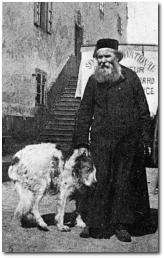
.jpg)
.jpg)
The St. Bernard is a giant dog. The average weight of the breed is between 65 and 120 kg (140 and 260 lb) or more, and the approximate height at the withers is 70 to 90 cm (28 to 35 in).[4]
The coat can be either smooth or rough; the smooth coat being close and flat while the rough is dense, flat, and more profuse around the neck and legs. The colour is typically a red shade with white, or a mahogany brindle with white. Black shading is usually found on the face and ears.
The tail is long and heavy, hanging low.
Eyes are usually brown, but sometimes can be icy blue, and should have naturally tight lids, with haws only slightly visible.
History
The ancestors of the St. Bernard share a history with the Sennenhunds. The St. Bernard, also called Alpine Mountain Dogs or Alpine Cattle Dogs, are the large farm dogs of the farmers and dairymen of most notably the French Alps, livestock guardians, herding dogs, and draft dogs as well as hunting dogs, search and rescue dogs, and watchdogs. These dogs are thought to be descendants of molosser type dogs brought into the Alps by the ancient Romans, and the St. Bernard is recognized internationally today as one of the Molossoid breeds.[5]
The earliest written records of the St. Bernard breed are from monks at the hospice at the Great St. Bernard Pass in 1707, with paintings and drawings of the dog dating even earlier.[6] The most famous St. Bernard to save people at the pass was Barry (sometimes spelled Berry), who reportedly saved somewhere between 40 and 100 lives. There is a monument to Barry in the Cimetière des Chiens, and his body was preserved in the Natural History Museum in Berne.[7] Another famous dog was Rutor, the faithful companion of the priest fr:Pierre Chanoux named after the peak Tête du Rutor located above the Little St Bernard pass. The classic St. Bernard looked very different from the St. Bernard of today because of cross-breeding. Severe winters from 1816 to 1818 led to increased numbers of avalanches, killing many of the dogs used for breeding while they were performing rescues.[8][9] In an attempt to preserve the breed, the remaining St. Bernards were crossed with Newfoundlands brought from the Colony of Newfoundland in the 1850s, and so lost much of their use as rescue dogs in the snowy climate of the alps because the long fur they inherited would freeze and weigh them down.[10]
The dogs never received any special training from the monks. Instead, younger dogs would learn how to perform search and rescue operations from older dogs.[11]
The Swiss St. Bernard Club was founded in Basel on 15 March 1884. The St. Bernard was the very first breed entered into the Swiss Stud Book in 1884, and the breed standard was finally approved in 1888. Since then, the breed has been a Swiss national dog.[6]
The dogs at the St Bernard hospice were working dogs that were smaller than today's show St Bernard's dogs. Originally about the size of a German Shepherd Dog,[12] the St Bernard grew to the size of today's dog as kennel clubs and dog shows emphasized appearance over the dog's working ability, along with a closed stud book.[13]
An open stud book would have allowed breeders to correct such errors by breeding in Working dog of other dog breeds.
Naming
The name "St. Bernard" originates from the Great and Little St. Bernard Hospice two traveler's hospices on the often treacherous Great and Little St. Bernard Passes in the Western Alps. Between Switzerland and Italy (Pennine Alps ) and between France and Italy in the Graian Alps, south of the former one, and few miles away from the Mont-Blanc. The passes, the lodges, and the dogs are named for Bernard of Menthon, the 11th century monk who established the stations.[14]
"St. Bernard" wasn't in widespread use until the middle of the 19th century. The dogs were called "Saint Dogs", "Noble Steeds", "Alpenmastiff", or "Barry Dogs" before that time.
Related breeds
The breed is strikingly similar to the English Mastiff, with which it shares a common ancestor known as the Alpine Mastiff. The modern St. Bernard breed is radically different than the original dogs kept at the St. Bernard hospice, most notably by being much larger in size and build. Since the late 1800s, the St. Bernard breed has been ever refined and improved using many different large Molosser breeds, including the Newfoundland, Great Pyrenees, Greater Swiss Mountain Dog, Bernese Mountain Dog, Great Dane, English Mastiff, and possibly the Tibetan Mastiff and Caucasian Ovcharka. Other breeds such as the Rottweiler, Boxer, and English Bulldog may have contributed to the St. Bernard's bloodline as well. It is suspected that many of these large breeds were used to redevelop each other to combat the threat of their extinction after World War II, which may explain why all of them played a part in the creation of the St. Bernard as seen today.[15]
The four Sennenhund breeds, the Grosser Schweizer Sennenhund (Greater Swiss Mountain Dog), the Berner Sennenhund, (Bernese Mountain Dog), the Appenzeller Sennenhund, (Appenzeller), and the Entlebucher Sennenhund (Entlebucher Mountain Dog) are similar in appearance and share the same location and history, but are tricolor rather than red and white.
The Russian army kennels crossbreed St Bernards with Caucasian Ovcharka to produce the Moscow Watchdogs that are still used as military service dogs in Russia today.[16] St Bernards have in common many characteristics of other Mountain dog breeds.

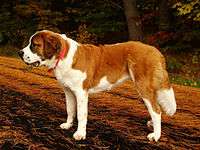 A St. Bernard with short coat
A St. Bernard with short coat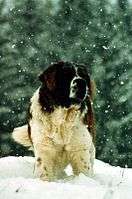 St. Bernard Dog in winter
St. Bernard Dog in winter Longhaired St. Bernards
Longhaired St. Bernards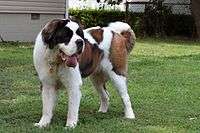 Longhaired St. Bernard Dog
Longhaired St. Bernard Dog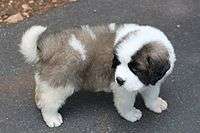 St. Bernard puppy with colours not distinctively pronounced
St. Bernard puppy with colours not distinctively pronounced
Kennel Club recognition
The St. Bernard is recognised internationally by the Fédération Cynologique Internationale as a Molosser in Group 2, Section 2. The breed is recognised by The Kennel Club (UK), the Canadian Kennel Club, and the American Kennel Club in the Working Dog breed group. The United Kennel Club in the United States places the breed in the Guardian Dog Group. The New Zealand Kennel Club and the Australian National Kennel Council place the breed in the Utility Group
Modern activities - Great St Bernard & Little St Bernard Pass

St. Bernard dogs are no longer used for Alpine rescues, the last recorded instance of which was in 1955. As late as 2004, the Great St Bernard Hospice still maintained 18 of the dogs for reasons of tradition and sentiment. In that year the Barry Foundation created breeding kennels for the breed at the town of Martigny down the Pass, and purchased the remaining dogs from the Hospice.
At the Little Saint Bernard pass, every year a celebration of the breed takes place on the pass and the town of Rosières-Montvalzan on the French side where Saint Bernard dogs lovers and breeders are gathering for a dog show and parades.[17]
The animals bred by the Foundation are trained to participate in a variety of dog sports including carting and weight pulling. The dogs at the Barry Foundation are reportedly smaller than the average St Bernard.
Health
The very fast growth rate and the weight of a St. Bernard can lead to very serious deterioration of the bones if the dog does not get proper food and exercise. Many dogs are genetically affected by hip dysplasia or elbow dysplasia. Osteosarcoma (bone cancer) has been shown to be hereditary in the breed.[18] They are susceptible to eye disorders called entropion and ectropion, in which the eyelid turns in or out. The breed standard indicates that this is a major fault. The breed is also susceptible to epilepsy and seizures, a heart disease called dilated cardiomyopathy, and eczema.
US and UK breed clubs put the average lifespan for a St. Bernard at 8–10 years.[19][20][21] A 2003 Danish breed survey (35 dogs) puts the median lifespan at 9.5 years while a UK breed survey in 2004 (53 dogs) puts the median lifespan at 7 years. In the UK survey about one in five lived to >10 years with the longest lived dog at 12 years and 9 months.[22][23]
A study of genetically related polyneuropathy in the breed was conducted.[24]
Temperament
Known as a classic example of a Gentle Giant, the Saint Bernard is calm, patient and sweet with adults, and especially children. However St. Bernards, like all very large dogs, must be well socialized with people and other dogs in order to prevent fearfulness and any possible aggression or territoriality. The biggest threat to small children is being knocked over by this breed's larger size. Overall they are a sweet, gentle, calm, loyal and affectionate breed, and if socialized are very friendly. Because of its large adult size, it is essential that proper training and socialization begin while the St. Bernard is still a puppy, so as to avoid the difficulties that normally accompany training large dogs. An unruly St. Bernard may present problems for even a strong adult, so control needs to be asserted from the beginning of the dog's training. While generally not instinctively protective, a St. Bernard may bark at strangers, and their size makes them good deterrents against possible intruders.[25][26]
The Saint Bernard was bred to be a working companion and to this day the St.Bernard lives to please its master and is an amiable yet hard worker. St.Bernards have retained their natural ability for scent work and depending on the skill of the trainer and the talents of the dog, St. Bernards can participate in tracking events or even become involved in search and rescue work.[27]
Notability
Record size

St. Bernards were exported to England in the mid-19th century, where they were bred with mastiffs to create an even larger dog. Plinlimmon, a famous St. Bernard of the time, was measured at 95 kg (210 lbs) and 87.5 cm (34 1⁄2ins), and was sold to an American for $7000.[14] Commercial pressure encouraged breeding ever larger dogs until "the dogs became so gross that they had difficulties in getting from one end of a show ring to another".[14]
An 1895 New York Times report mentions a St. Bernard named Major F. measuring 8 feet 6 inches (2.59 m) in length, who, if the claims are true, would be the longest dog in history.[28] Another St. Bernard named Benedictine V Schwarzwald Hof (Pierson, Michigan - USA) also reached 315 lb (143 kg), which earned a place in the 1981 edition of the Guinness Book of World Records.[29]
In media
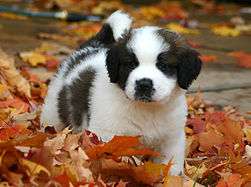
St. Bernards are often portrayed, especially in old live action comedies such as Swiss Miss, the TV series Topper, and classic cartoons, wearing small barrels of brandy around their necks. Avalanche victims supposedly drank the brandy to stay warm while awaiting rescue, although this is medically unsound. The monks of the St. Bernard Hospice deny that any St. Bernard has ever carried casks or small barrels around their necks; they attribute the image to an 1820 painting by Edwin Landseer, perhaps Alpine Mastiffs Reanimating a Distressed Traveler (which became a popular engraving in 1831 by Charles Landseer).[30] The monks did keep casks around for photographs by tourists.[31]
A Punch magazine cartoon from 1949 depicts a man with a St. Bernard and several puppies, all of which are wearing neck casks. The man explains, "Of course, I only breed them for the brandy."
A frequent joke in old MGM and Warner Brothers shorts is to depict the dogs as compulsive alcoholics who engage in frequent nips from their own casks.
Famous St. Bernards

- Bachelor, Resident Dog, The Ritz-Carlton, Bachelor Gulch
- Burtonswood (Bossy Boots). English and Irish Crufts Supreme Champion (1974), Breeder was the late Miss Marjorie Hinds.
- Bamse, a Norwegian dog honoured for exploits during World War II memorial statue in Montrose, Scotland where he died in 1944
- Barry, famous Alpine rescue dog
- Bernie, mascot of the Colorado Avalanche
- Bernie "Saint" Bernard, mascot of the saints in Dubuque
- Bernie, mascot of the Northampton Saints
- Gumbo, team mascot for the New Orleans Saints
- Porthos, J.M. Barrie's dog
- Schnorbitz, on-stage partner of British comedian Bernie Winters during his later career
- Schotzie & Schotzie "02", beloved pets and mascots of Cincinnati Reds' owner
- Scipio Saint Bernard of Orville Wright[32]
- Shirley Temple and a St. Bernard friend
- Wallace (currently Wallace VI), mascot of The Canadian Scottish Regiment (Princess Mary's)
Fictional dogs

- See generally: List of fictional dogs
- Båtsman, a St. Bernard in Astrid Lindgren's story Vi på Saltkråkan
- Beethoven (from the movie series of the same name) The 1992 comedy film Beethoven features a large, friendly but troublesome St. Bernard and, in later sequels, his mate and their brood of unruly pups. According to the producers of the sequel Beethoven's 2nd, the St. Bernards used in the film grew so fast during filming that over 100 St. Bernard puppies were cast to portray the sequel's four puppies (Tchaikovsky, Chubby, Dolly, and Mo) and a mother St. Bernard named Missy.
- Bolivar a/k/a Bornworthy and Bernie, Donald Duck's non-anthropomorphic pet, and Bolivar's son, Behemoth
- Buck, from Jack London's novel, The Call of the Wild, is described as half St. Bernard and half "Scotch shepherd dog",[upper-alpha 1][upper-alpha 2] but was rendered as full St. Bernard in at least one of the six movie versions.[upper-alpha 3]
- Cujo, a dog who contracts rabies and becomes crazed, terrorizing the residents of the fictional town of Castle Rock, Maine from the 1981 Stephen King novel Cujo and the 1983 film of the same name.
- George, from the 1971 movie and its 1972–74 spinoff television series.
- Josef, from the Japanese anime series Heidi, Girl of the Alps (Alps no Shoujo Heidi).
- Nana, in the Disney and Columbia Pictures Peter Pan movies (but a Newfoundland in J.M. Barrie's original play and novel)
- Neil, the martini-slurping St. Bernard of George and Marion Kerby in the 1950s television series Topper. This was a follow up to Topper, Topper Takes a Trip, and Topper Returns.
Legend
The famous St. Bernard dog Barry found a small boy in the snow and persuaded the boy to climb on his back, and then carried the boy to safety.[10]
See also
Bibliography
Footnotes
- ↑ Buck in "Call of the Wild" is described thus: "His (Buck's) father, Elmo, a huge St Bernard, had been the Judge's inseparable companion, and Buck bid fair to follow in the J way of his father. He was not so large,—he weighed only one hundred and forty pounds,—for his mother, Shep, had been a Scotch shepherd dog. Nevertheless, one hundred and forty pounds, to which was added the dignity that comes of good living and universal respect, enabled him to carry himself in right royal fashion." Call of the Wild (novel).
- ↑ The use of the term "Scotch shepherd dog" is an archaic Victorian phrase which probably refers to Scotch Collie, or Old Time Farm Shepherd, but might refer to English Shepherd. "Name That Breed – A Collie By Any Other Name…". Old-Time Farm Shepherd. Retrieved 9 October 2012. "Defining a Breed: An Apologia of the OTFS". Retrieved 9 October 2012.
- ↑ A St. Bernard was used in the Clark Gable version, The Call of the Wild (1935 film). Three Leonberger 'actors' (one was a female, and two males) played the starring dog "Buck" in The Call of the Wild: Dog of the Yukon (1997), "Call of the Wild - Dog of the Yukon". Internet Movie Data Base. Retrieved 8 October 2012. a Canadian rendition of Jack London's Call of the Wild starring Rutger Hauer as John Thornton (narrated by Richard Dreyfuss). "Leonberger Facts". American Kennel Club. Retrieved 8 October 2012. Nevertheless, films and television renditions have varied the dog breed. The book was also adapted in The Call of the Wild by D. W. Griffith (1908); a second silent film (1923) by Hal Roach; The Call of the Wild (1972 film) and Call of the Wild 3D (2009). It has also been the subject of three television programs or films: The Call of the Wild, a 1976 American TV film starring John Beck, with a screenplay by James Dickey; The Call of the Wild, a 1993 American TV film starring Rick Schroder; and Call of the Wild (TV series), a 2000 adventure series on Animal Planet.
References
- ↑ , Fédération Cynologique Internationale: Saint Bernard Breed Standard. Retrieved 9 August 2016
- ↑ The pronunciation /ˈbɜːrnərd/ is chiefly British and the pronunciation /bərˈnɑːrd/ is chiefly North American.
- ↑ "History of the Saint Bernard breed". Relais du Petit Saint Bernard. Retrieved 5 August 2016.
- ↑ "Australian National Kennel Council". Ankc.org.au. 15 December 2011. Retrieved 25 July 2015.
- ↑ "Breeds nomenclature" (PDF). Fédération Cynologique Internationale. Retrieved 15 January 2014.
- 1 2 St. Bernard, Vertebrate Animals Department, Naturhistoriches Museum der Burgergemeinde Bern, archived from the original on 2 September 2011, retrieved 10 October 2014
- ↑ "The Legendary Barry at the Natural History Museum". Natural History Museum of Bern. Naturhistorisches Museum der Burgermendiz Bern. Retrieved 20 March 2011.
- ↑ Blumberg, Jess (1 January 2008). "A Brief History of the St. Bernard Rescue Dog: The canine's evolution from hospice hound to household companion". Smithsonian magazine. Retrieved 12 June 2011.
- ↑ "The Newfoundland". Dog Owners Guide. Retrieved 13 June 2011.
- 1 2 Clark, Anne Rogers; Andrew H. Brace (1995). The International Encyclopedia of Dogs. Howell Book House. pp. 381–383. ISBN 0-87605-624-9.
- ↑ "Dogs Learn by Modeling the Behavior of Other Dogs".
- ↑ "In 1962, an avalanche dog over to Great Dixence is organized at the initiative of Canine Club of Sion. A TSR camera is present on The working St Bernard dogs at the hospice was still smaller than the show St Bernard dogs during 1962 and premises". Retrieved 2 September 2015.
- ↑ "St Bernard breeding: why Barry got a bigger head". Retrieved 2 September 2015.
- 1 2 3 "Dog Owner's Guide Profile: The St. Bernard". Canismajor.com. Retrieved 19 December 2011.
- ↑ "The History of the Mastiff — English Mastiff — dog of dogs". Webbusiness.no. Retrieved 19 December 2011.
- ↑ "470 Методико-кинологический центр служебного собаководства ВС РФ (470th Methodology-сynology centre of military dog breeding)". http://vitalykuzmin.net/. Retrieved 2 September 2015. External link in
|publisher=(help) - ↑ "The Little Saint Bernard pass, dog parade". Le Dauphiné Libéré. Retrieved 5 August 2016.
- ↑ Bech-Nielsen; S.; Haskins; M. E.; et al. (1978). "Frequency of osteosarcoma among first-degree relatives of St. Bernard dogs". J Natl Cancer Inst. 60 (2): 349–53. PMID 271748.
- ↑ "Breed Information". The English Saint Bernard Club. Retrieved 28 March 2012.
- ↑ "Breeder Advertisements". Saint Bernard Club of America. Retrieved 28 March 2012.
- ↑ Cassidy, Kelly M. (1 February 2008). "Breed Longevity Data". Dog Longevity. Retrieved 18 September 2012.
- ↑ Proschowsky, H. F.; Rugbjerg, H.; Ersbøll, A. K. R. (2003). "Mortality of purebred and mixed-breed dogs in Denmark". Preventive Veterinary Medicine. 58 (1–2): 63–74. PMID 12628771. doi:10.1016/S0167-5877(03)00010-2.
- ↑ "Summary results of the Purebred Dog Health Survey for the St Bernard breed" (PDF). Kennel Club/British Small Animal Veterinary Association Scientific Committee. Retrieved 28 March 2012.
- ↑ Ekenstedt, Kari J.; Becker, Doreen; Minor, Katie M.; Shelton, G. Diane; Patterson, Edward E.; Bley, Tim; Oevermann, Anna; Bilzer, Thomas; Leeb, Tosso; Drögemüller, Cord; Mickelson, James R. (2 October 2014). "An ARHGEF10 Deletion Is Highly Associated with a Juvenile-Onset Inherited Polyneuropathy in Leonberger and Saint Bernard Dogs". PLOS Genetics. PLOS. 10: e1004635. doi:10.1371/journal.pgen.1004635. Retrieved 13 March 2015.
- ↑ Stenmark, Betty-Anne. A New Owner's Guide to Saint Bernards. New Jersey, U.S.A.: T.F.H. pp. 23–25. ISBN 0-7938-2810-4.
- ↑ Walker, Joan Hustace (1998). Saint Bernards A Complete Pet Owner's Manual. Hong Kong: Barrons. pp. 14–22. ISBN 0-7641-0288-5.
- ↑ Hustace Walker, Joan (2000). Saint Bernards: Everything About Purchase, Care, Nutrition, Breeding, Behavior and Training (Barron's Complete Pet Owner's Manuals). p. 11.
- ↑ "A Large St. Bernard Dog Killed". The New York Times. 31 December 1895.
- ↑ "Dogs from Our Past". Schwarzwald Hof Kennels. Retrieved 3 June 2011.
- ↑ "Legend of the St. Bernard Barrel". It's the dogs' life. Archived from the original (http) on 18 February 2014. Retrieved 19 January 2016.
- ↑ Pickow, George (1957). "The Great St. Bernard Hospice Today". National Geographic, January 1957. Archived from the original (http) on 15 December 2005. Retrieved 26 January 2006.
- ↑ McPherson, Stephanie Sammartino; Gardner, Joseph Sammartino (2003). Wilbur & Orville Wright: taking flight. Minneapolis, MN: Carolrhoda, Inc. p. 103. ISBN 1-57505-443-4. Retrieved 6 January 2012.
External links
| Wikimedia Commons has media related to St. Bernard dog. |
- St. Bernard at DMOZ
